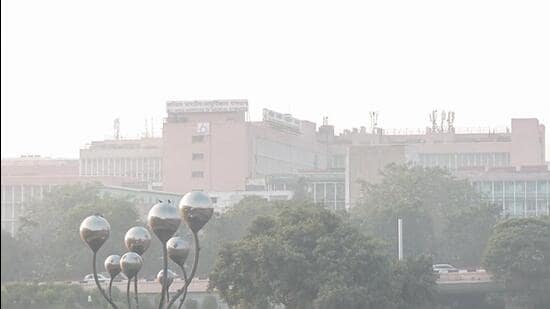Our Terms & Conditions | Our Privacy Policy
Delhi: Bad air days are here with an uptick in farm fires | Latest News India
The Capital’s air quality took its inevitable turn for the worse late on Sunday evening with the air quality index (AQI) surpassing 300 at 11pm, with even more pollution looming on the horizon as satellites picked up a steady increase in farm fires in Punjab and Haryana.
A haze envelops AIIMS as the AQI dropped to 277 in New Delhi on Sunday. (ANI)
Data accessed by HT from Nasa’s Fire Information for Resource Management System (FIRMS) showed the two agrarian states recorded 90 fires on average in the past week. While the number is significantly lower than past years, when an average of 600 or so fires were reported in the same period, farmers and officials said crop residue burning will pick up in coming days.
“Delhi’s air quality is likely to be in the lower end of the ‘very poor’ category from Monday till Wednesday. The outlook for the subsequent six days show AQI is likely to oscillate between ‘very poor’ and ‘poor’,” the forecast from the Early Warning System (EWS) on air pollution issued on Sunday said, attributing the deterioration to calm winds, and stubble or waste burning.
The Central Pollution Control Board (CPCB) reported Delhi’s average AQI at 277 (poor) at 4 pm on Sunday, marking the fifth consecutive day of poor air quality. The level then rose steadily, reaching 289 by 7pm and 303 by 11pm.
An Indian Meteorological Department (IMD) official explained, “Winds are predominantly remaining calm at night, which leads to pollutants accumulating. Winds were slow to calm during the day on Sunday too.” This meteorological condition has exacerbated the pollution crisis, trapping pollutants close to the ground.
The Decision Support System (DSS), part of the ministry of earth sciences, estimated the contribution of stubble burning to Delhi’s air pollution at 1.8% on Sunday, up from 0.7% on Saturday. This contribution is forecast to rise further, potentially reaching 2.9% on Monday and 6.9% by Tuesday. The DSS data also showed that pollution from neighbouring NCR towns was impacting Delhi’s PM 2.5 levels, with Gautam Buddha Nagar contributing 11.3%, followed by Ghaziabad at 8.25% and Bulandshahr at 7.7%.
In Punjab nearly 15% of the paddy crop has been harvested and the state has recorded 1,445 cases of farm fires since September 15, when the state’s remote sensing centre started recording.
Despite efforts to curb farm fires, authorities anticipate that the number of incidents this season may not see a drastic reduction compared to previous years, in part due to a controversy regarding procurement that has seen farmers go on protest because their harvests are not being acquired.
Ravi Sher Singh, a paddy grower from Muchhal village in Amritsar district, added, “Farmers are facing brunt from multiple sides. They are being penalised for burning straw, need to spend extra on managing straw, and their produce is not being procured.”
Sukhdev Singh Kokri Kalan, general secretary of Bhartiya Kisan Union (Ughrahan), too highlighted the challenges faced by farmers and indicated the low numbers of fires recorded till now are because farmers are protesting. “Farmers are in trouble, and sitting on dharna at 51 different places in the state seeking procurement and payment of their crop. In such circumstances, we expect them not to burn.”
Kalan added that “many farmers cannot afford in-situ and ex-situ management, which seems difficult”, referring to the practice of either mixing the paddy remnants back into the ground or removing them from the fields – instead of setting them alight, which is a quicker and cheaper way to clear the fields for the next season’s sowing.
Last year, the total farm fire count in Punjab dipped by 25% compared to 2022 figures, from 49,922 to 36,623. However, the area under stubble fires increased by 27%, from 1.5 million acres in 2022 to 1.9 million acres in 2023. This year, the harvest is slower compared to last season, partly due to delayed sowing and rainfall in late September.
Jaswant Singh, director of agriculture, stated, “We are in touch with farmers, village panchayats and deputy commissioners to bring down farm fires as far as possible. Our department is motivating farmers to stop the practise which is harming human health and environment.” He added that 13,000 subsidised machines have been given to farmers this season for residue management.
Adarsh Pal Vig, chairman of the Punjab Pollution Control Board, expressed optimism: “Efforts are on to bring down the number [of farm fires]. We are supporting the farmers in all possible manner and we hope to make visible difference this season.”
The situation has caught the attention of higher authorities, with the Supreme Court summoning the chief secretaries of Punjab and Haryana for October 23 to provide an update on efforts to curb farm fires, aiming for zero burning in the fields.
Additionally, 136 FIRs have been registered against farmers for burning straw, over ₹10 lakh in environmental compensation has been imposed, and 383 farmers have received red entries in their land records for violating orders.
In Delhi, the Commission for Air Quality Management (CAQM) may invoke stage 2 of the Graded Response Action Plan (GRAP) if the AQI crosses 300. This would call for augmented bus and metro services and increased parking fees across Delhi-NCR.
Images are for reference only.Images and contents gathered automatic from google or 3rd party sources.All rights on the images and contents are with their legal original owners.



Comments are closed.